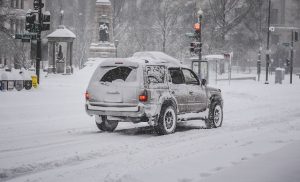 Winter time, especially in the more northern states like Pennsylvania, can be tough on cars. As a caring car owner, you’re probably looking for ways to protect your beloved vehicle throughout these harsher months, so that you can cruise right on into the spring without a hitch. Your wheels and tires should be a part of your winter maintenance list, so here’s how you can keep them protected this season.
Winter time, especially in the more northern states like Pennsylvania, can be tough on cars. As a caring car owner, you’re probably looking for ways to protect your beloved vehicle throughout these harsher months, so that you can cruise right on into the spring without a hitch. Your wheels and tires should be a part of your winter maintenance list, so here’s how you can keep them protected this season.
Wax Your Wheels Regularly
Road salt, dirt, and grime can cling to your chrome wheels and cause them to erode and rust. Much like the body of your car, your wheels can be waxed to protect against this specific type of damage. Use a chrome-friendly product to coat your wheels in wax when they are clean. After you’ve applied the wax, you’ll find that dirt and salt can be rinsed right off your wheels.
Just be sure to wax and clean your wheels regularly, as even dried salt can cause continued damage to this part of your car. High-pressure hoses can be used to blast away this grime, providing your wheels with the ultimate protection.
Have Your Tires Aligned
Disguised potholes, snow piles, and other winter hazards can cause the alignment of your tires to get out of whack. When this happens, your car can tend to lean or pull to one side, thus causing the tires on one side of your car to wear faster than the others. In order to prevent this from happening, you can have your tires aligned by a professional. You’ll find that your car is better balanced, and you can drive that much more safely this winter.
Keep Your Tire Pressure In-Check
Lower temperatures can cause the air pressure in your tires to go down. Not only does this decrease the fuel efficiency of your car, but it can also cause your tires to wear faster as they have more contact with the road. Most cars have electronic tire pressure displays, which makes the task of keeping your tire pressure in check that much easier.
However, an old fashioned tire pressure gauge can always help you determine whether or not your tires have enough air in them. Double-check the suggested tire pressure of your vehicle by locating this information on the inside of your driver door panel or in your car’s manual.
Use the Appropriate Tires for the Season
It can be difficult to protect all-season tires from winter weather simply because they are not built specifically for that type of driving condition. Secure your car with the appropriate winter or snow tires, and keep a set of tire chains in your vehicle just in case. Doing so will better protect the longevity of your tires as well as increase your own safety.
With these tips, you should be able to protect your wheels and tires from the unforgiving winter weather. When the weather starts to warm back up, have your winter tires changed out for your summer or all-season set. Also be sure to visit your local mechanic to ensure your car is safe to drive after enduring the snow season.
Image via Pixabay





